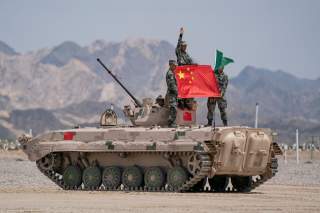China's Type 99 Tank Is Here (And It Can Wage War Against Anyone)
China's military modernization has been a long time coming.
The new A2 is also thought to have a laser-based communication system which can be used to identify friendly vehicles and transmit encrypted data.
The T-90 tank, on the other hand, relies on the Shtora “soft kill” Active Protection System, which not only jams lasers with its own emitters, but also deploys aerosol grenades to create a laser-obscuring cloud around the vehicle.
The M1 Abrams lacks its own Laser Warning Receiver, Active Protection Systems or Explosive Reactive Armor, though it is conceivable future upgrades will incorporate some of these features.
For now, the M1A2 relies on its excellent Chobham composite armor, which has been tweaked over the years and believed to be equivalent to 800 millimeters or more of rolled hardened armor (RHA) verses tank sabot shells, or 1300 millimeters versus the shaped charges used in rockets and missiles. For comparison, the T-90 is believed to have a maximum armor of around 650 RHA. The Abrams also benefit from having separately stowed ammunition, making its less likely to catastrophically detonate when hit by enemy fire.
The Type 99’s combination of composite and modular space armor is believed to offer armor protection close or equivalent to the Abrams. One sources claims it offers protection equivalent to around 1100 RHA, though the actual effectiveness is classified.
Mobility:
The Type 99 is by far the most nimble of the bunch, able to sprint up to 50 miles per hour on roads. The M1 Abrams and the T-90MS used by India follow behind at 42 and 45 miles per hour respectively, while the T-90A trails at 35. However, the gas-guzzling turbine-powered M1A2 can only travel 240 miles before requiring refueling, while both the Type 99 and T-90 have ranges over 300 miles. Furthermore, the M1’s greater weight makes it the hardest to transport and deploy.
A last note is the Type 99 features new digital maintenance systems similar to those entering into use in the latest upgrade of the M1 Abrams.
So all in all, while the Abrams arguably retains the best firepower of the three, the Type 99 seems likely to be better protected thanks to its multi-layered defensive systems. And it’s faster and has longer range.
The T-90A is generally outclassed by the other two, but the T-90MS, with its Relikt armor, improved sights and more powerful engines, can hold its own.
However, one should keep in mind the actual performance of the Type 99’s armor, gun and electronic systems is not certain, particularly as the vehicle has not been exported, whereas both the M1 and T-90 have been used in action by multiple operators. Beijing likes to keep the details of its technology close, and also has an incentive to talk up the capabilities of its hardware.
Nonetheless, the majority of the evidence available suggests that, despite its hordes of Type 59s, China is capable of designing and fielding a first-class main battle tank. This fits in well with President Xi Jinping’s recent push to downsize in quantity, and improve in quality, its armed forces.
Sébastien Roblin holds a Master’s Degree in Conflict Resolution from Georgetown University and served as a university instructor for the Peace Corps in China. He has also worked in education, editing, and refugee resettlement in France and the United States. He currently writes on security and military history for War Is Boring. This first appeared in 2016.
Image: Reuters.

